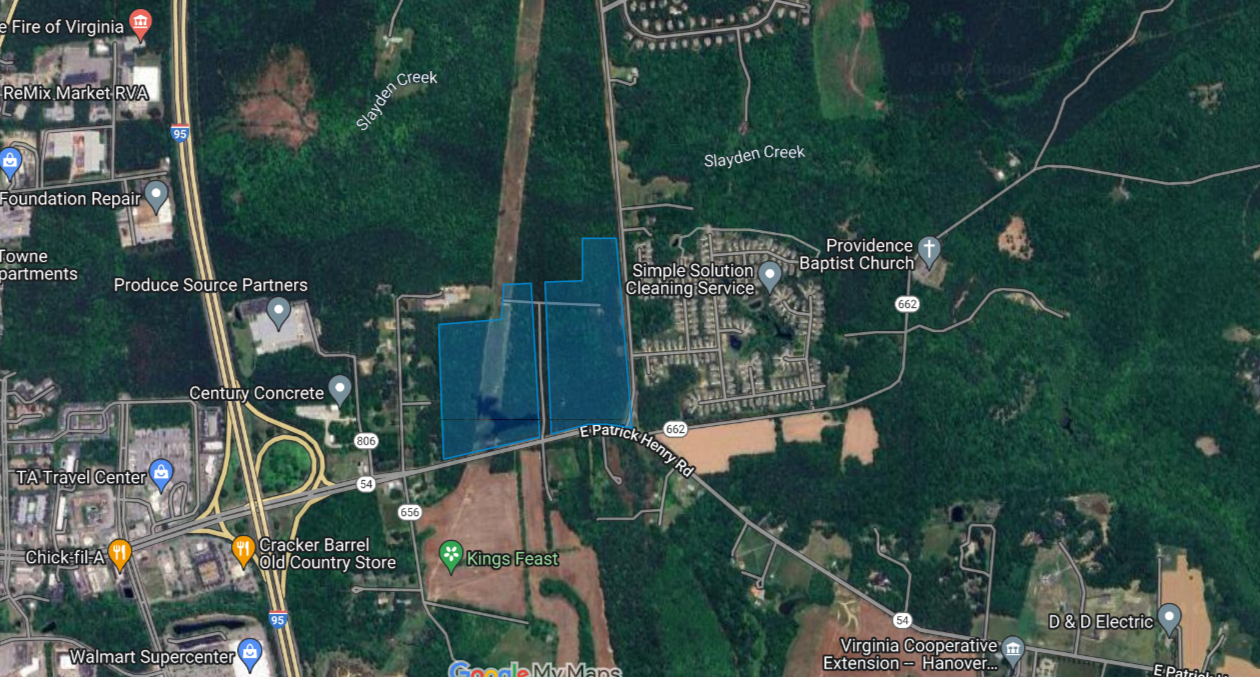
Patriot Glenn (outlined in blue) is a proposed mixed-use development that would feature more than 100 homes and commercial space on a 60-acre site in east Ashland. (Google Maps)
A proposal currently making its way though Ashland’s zoning approval process would add new for-sale homes as well as retail and restaurant space to the east side of the town.
Local developer Hank Wilton is planning Patriot Glenn, a mixed-use development with 131 residential units and commercial space on a 60-acre site where East Patrick Henry and Providence Church roads meet, just off Exit 92A on Interstate 95.
The development is planned to feature only for-sale homes, with a mix of single-family detached houses, cottage-style houses and townhomes. Price points are expected to range between $350,000 and $500,000, Wilton told the Ashland Planning Commission earlier this month.
“We’ll have something for everybody, I think, with at least three different price points,” said the developer, who was formerly the head of The Wilton Cos. and now operates Wilton Acquisition.
Wilton hasn’t submitted a specific plan for the commercial piece of the project but is seeking Highway Commercial (B-2) zoning. He said the development would focus on attracting restaurant operators and retailers for the commercial area.
“We can envision some retail sales, a restaurant with outdoor seating where you could have coffee in the morning and you might want to have a beer with your friends outside in the late afternoon,” he told the Planning Commission.
The B-2 zoning district’s by-right uses include restaurants, retail stores of fewer than 25,000 square feet, hotels and offices among other uses. Other commercial uses that would require a conditional-use permit include car washes, hospitals, shopping centers and retail stores larger than 25,000 square feet.
The development would have two vehicular entrances on East Patrick Henry Road (Route 54) and two entrances on Woodside Lane, according to a site plan. The commercial area on East Patrick Henry is expected to take the form of two pad sites.
The proposal is seeking to rezone the majority of the property, which consists of two parcels, one of which is 10190 East Patrick Henry Road, to B-2 and Planned Unit Development from its current Rural Residential (RR-1) designation. A small portion of the project site, which is home to a telecommunications tower, would retain its current zoning.
The project area is largely undeveloped. In addition to the telecommunications tower, a portion of the site is occupied by power lines, and most of the development would take place to the east of them. The maximum density of the development’s residential component would be 2.39 units per acre.
A cost estimate for the project is still being developed.
The parcels are under contract to be sold to Wilton in a deal that’s expected to close pending the rezoning of the site. The land has been assessed at about $700,000, per online land records. The project site is split in two by a strip of land that’s part of a larger parcel owned by Hanover County.
The commission deferred consideration of the project at its Feb. 13 meeting on the recommendation of town staff, which wanted more time to review the case and work on the commercial area’s design proffers with the applicant.
Patriot Glenn is expected to return to the commission on March 13, and then Town Council will consider final approval of the project at a later date.
Patriot Glenn has been a couple years in the making and, if approved, would bring further development to that eastern section of Ashland.
Rogers-Chenault got zoning approval in August from the Hanover Board of Supervisors for 150 age-restricted homes on a site where East Patrick Henry Road and Providence Church Road meet. Developer Todd Rogers told BizSense last week that site plan review for that project was underway and construction was expected to start in the summer.
On the other side of East Patrick Henry Road, WestDulles Properties is working on lining up approvals for Iron Horse Business Park, which would be built on an assemblage that straddles Ashland’s boundary with Hanover.

Patriot Glenn (outlined in blue) is a proposed mixed-use development that would feature more than 100 homes and commercial space on a 60-acre site in east Ashland. (Google Maps)
A proposal currently making its way though Ashland’s zoning approval process would add new for-sale homes as well as retail and restaurant space to the east side of the town.
Local developer Hank Wilton is planning Patriot Glenn, a mixed-use development with 131 residential units and commercial space on a 60-acre site where East Patrick Henry and Providence Church roads meet, just off Exit 92A on Interstate 95.
The development is planned to feature only for-sale homes, with a mix of single-family detached houses, cottage-style houses and townhomes. Price points are expected to range between $350,000 and $500,000, Wilton told the Ashland Planning Commission earlier this month.
“We’ll have something for everybody, I think, with at least three different price points,” said the developer, who was formerly the head of The Wilton Cos. and now operates Wilton Acquisition.
Wilton hasn’t submitted a specific plan for the commercial piece of the project but is seeking Highway Commercial (B-2) zoning. He said the development would focus on attracting restaurant operators and retailers for the commercial area.
“We can envision some retail sales, a restaurant with outdoor seating where you could have coffee in the morning and you might want to have a beer with your friends outside in the late afternoon,” he told the Planning Commission.
The B-2 zoning district’s by-right uses include restaurants, retail stores of fewer than 25,000 square feet, hotels and offices among other uses. Other commercial uses that would require a conditional-use permit include car washes, hospitals, shopping centers and retail stores larger than 25,000 square feet.
The development would have two vehicular entrances on East Patrick Henry Road (Route 54) and two entrances on Woodside Lane, according to a site plan. The commercial area on East Patrick Henry is expected to take the form of two pad sites.
The proposal is seeking to rezone the majority of the property, which consists of two parcels, one of which is 10190 East Patrick Henry Road, to B-2 and Planned Unit Development from its current Rural Residential (RR-1) designation. A small portion of the project site, which is home to a telecommunications tower, would retain its current zoning.
The project area is largely undeveloped. In addition to the telecommunications tower, a portion of the site is occupied by power lines, and most of the development would take place to the east of them. The maximum density of the development’s residential component would be 2.39 units per acre.
A cost estimate for the project is still being developed.
The parcels are under contract to be sold to Wilton in a deal that’s expected to close pending the rezoning of the site. The land has been assessed at about $700,000, per online land records. The project site is split in two by a strip of land that’s part of a larger parcel owned by Hanover County.
The commission deferred consideration of the project at its Feb. 13 meeting on the recommendation of town staff, which wanted more time to review the case and work on the commercial area’s design proffers with the applicant.
Patriot Glenn is expected to return to the commission on March 13, and then Town Council will consider final approval of the project at a later date.
Patriot Glenn has been a couple years in the making and, if approved, would bring further development to that eastern section of Ashland.
Rogers-Chenault got zoning approval in August from the Hanover Board of Supervisors for 150 age-restricted homes on a site where East Patrick Henry Road and Providence Church Road meet. Developer Todd Rogers told BizSense last week that site plan review for that project was underway and construction was expected to start in the summer.
On the other side of East Patrick Henry Road, WestDulles Properties is working on lining up approvals for Iron Horse Business Park, which would be built on an assemblage that straddles Ashland’s boundary with Hanover.




Putting a roundabout at Patrick Henry and Woodside would be a good step as well.
I just love the “mixed use” aspect and term now; take a single or larger group of parcels stick a Panera and a 7-Eleven out front of the development on the highway and some residential homes behind it in wah-la your mixed-use!
I agree. I’ve said for years these types of development should be called multi-use developments. It is not mixed-use unless it is vertically mixed or at the very least much better integrated. This is essentially a commercial project next to a residential project.
Not exactly sure what’s going on with the site plan, but pretty safe to say it’s not really a mixed-use development.